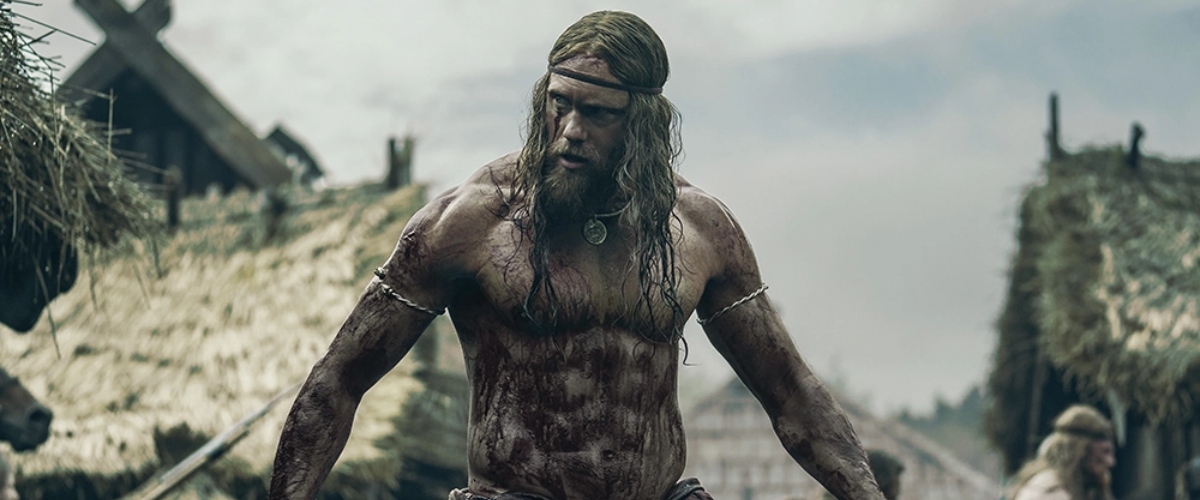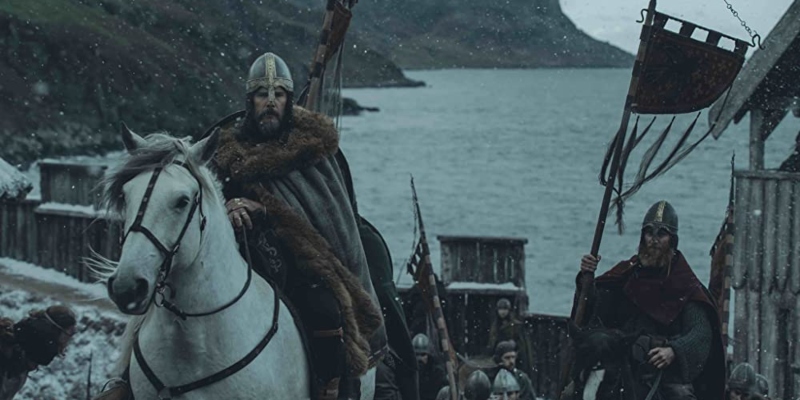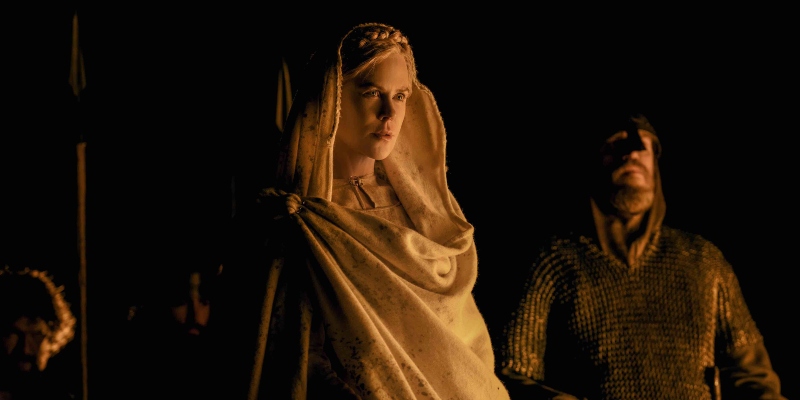The Northman isn’t an adaptation of Hamlet.
The film is an adaptation of one of Shakespeare’s sources, a story told in the medieval historian Saxo Grammaticus’s History of the Danes. The Northman overleaps Hamlet. It’s a “Not Shakespeare” adaptation, to borrow the title of Christy Desmet, Natalie Loper, and Jim Casey’s recent book.
Yet people today usually only know of Saxo because of Shakespeare. The Northman exploits the same Shakespearean text it avoids: the filmmakers are what Valerie Fazel and Louise Geddes call “Shakespeare users.”
Scholarly knowledge of Saxo, Shakespeare, Hamlet, and Shakespearean adaptation can clarify The Northman. And debates surrounding The Northman—such as the appropriation of Viking culture in modern white supremacist movements—can be read back into Saxo and Shakespeare.
The five sections that follow address the history of Hamlet adaptation, the idea of “the north” in pre-modern Europe, the tradition of violent masculine vengeance, the feminist reading needed to recover authentic representation of women in this myth, and the white supremacist underpinnings of the film.
Adaptation
By Selorna Ackuayi, Graham Blanks, Elizabeth Roosevelt, and Benjamin Rosa
What do you do with Hamlet when Hamlet has been done to death? That’s the question Sonya Freeman Loftis, Allison Kellar, and Lisa Ulevich ask in Shakespeare’s Hamlet in an Era of Textual Exhaustion. The answer for American director Robert Eggers and Icelandic author Sjón was to circumvent Hamlet and go to its source, Saxo Grammaticus’s History of the Danes.
Writing in Latin, Saxo completed his Gesta Danorum around 1208-18. It’s Hamlet without Hamlet, to borrow the title of Margareta de Grazia’s book—the European international relations without the psychological introspection so celebrated in Shakespeare’s play.
It’s the 7th century, and we’re in the Danish province of Jutland. Amleth is the son of King Horwendil, who is killed by his brother, Feng, who then marries his dead brother’s wife, Gerutha. Amleth vows revenge, “but feared lest too shrewd a behaviour might make his uncle suspect him. So he chose to feign dullness, and pretend an utter lack of wits.” The cunning Amleth brings “a foster brother”—the future Horatio—and “the woman whom his uncle had dispatched”—the future Ophelia—into his plot. After a jaunt to Britain accompanied by “two retainers of Feng”—who become Rosencrantz and Guildenstern—Amleth burns his uncle’s palace to the ground and decapitates Feng. Amleth becomes king. Saxo doesn’t know which to praise more, “his wit or his bravery.”
Remarkably, by returning to Saxo’s Amleth, The Northman is both pre-Hamlet and post-Hamlet.András Kiséry’s Hamlet’s Moment maps out the path from Saxo to Shakespeare. Gesta Danorum was printed in Paris in 1514 then translated into French by François de Belleforest in 1570. A Hamlet play—now called the Ur-Hamlet—appeared in London in 1589, about ten years before Shakespeare’s version was first performed.
In 1894, Oliver Elton translated Gesta Danorum into English for the first time. The 20th century was then flooded with Hamlet—from Laurence Olivier’s Hamlet (1948) to Akira Kurosawa’s The Bad Sleep Well (1960), from Tom Stoppard’s Rosencrantz & Guildenstern Are Dead (1966) to The Lion King (1994). For Loftis, Kellar, and Ulevich, “As our various Hamlets become more and more outlandish (more destructive, more creative, more subversive), less human (animal Hamlet, computergenerated Hamlet), and more commercial (tote bag Hamlet, T-shirt Hamlet, cookie Hamlet), it might be fair to wonder if Hamlet is, in some sense, a cultural text that is becoming increasingly exhausting and exhausted, used up, overdone.”
Hamlet is so exhausted that The Northman isn’t even the first adaptation of Saxo’s History of the Danes. In 1994, filmmaker Gabriel Axel directed Prince of Jutland, also known as Royal Deceit, with a young Christian Bale in the title role.
The fear of “exhausting” Hamlet has led to “Post-Hamlet” adaptations that explore a Hamlet-inspired world without the titular prince, say Loftis, Kellar, and Ulevich. Remarkably, by returning to Saxo’s Amleth, The Northman is both pre-Hamlet and post-Hamlet.
Hamlet and The Northman are both examples of “medievalism,” which Tom Shippey defines as “any post-medieval attempt to re-imagine the Middle Ages, or some aspect of the Middle Ages, for the modern world.” Medievalism can be dangerous, Shippey says, especially in light of the “the nationalist medievalizing of the 19th and 20th centuries in Europe.” Or medievalism might make us feel that, whatever we do today, it’s never as bad as the state of the world in those times. Audiences watching The Northman can think, Phew, glad we’re past that. Look at us now! Perhaps Elizabethan audiences watching Hamlet thought the same.
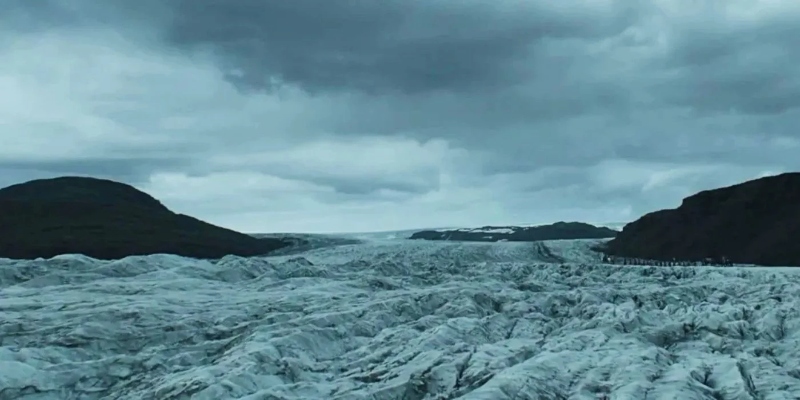
The North
By Emily Dial, Hannah Gadway, Keegan Harkavy, Theo Harper, and Michael Pontius
Denmark wasn’t north enough for The Northman. Eggers and Sjón set their film in a 10th-century Iceland populated with Vikings instead of Shakespeare’s royal Danish court. In doing so, The Northman draws upon what Andrew Hadfield calls “the idea of the north” in pre-modern European literature.
The north was invented by the south. The Roman historian Tacitus, while blasting Nero’s tyranny, characterized the north as a land of “hard liberties” and the south—Rome—as one of “disgraceful over-indulgence,” Hadfield says. As life in the south got too easy, citizens descended into corruption and excess, vice and impurity, hedonism and licentiousness, orgies and drunkenness. Intellectuals of the south strived for the virtue of the north.
According to Hadfield, northerners were “characterised by their savagery and military aggression, masculine virtue, sexual restraint and democratic political forms.” The North was a place of restraint and seriousness, a land of natural liberty where conflicts were settled with weapons. When justice fails, heroes restore it through violent revenge.
The Northman stands against tyranny, but it is also motivated by the sense of northern superiority in Saxo’s text.Saxo’s Amleth embodies the north. He is ruthless and vengeful but honest, honorable, and cunning. After avenging his father, Amleth delivers a lengthy speech that draws from Roman historian Livy’s description of the legendary founder of the Roman Republic, L. Junius Brutus, who deposed his uncle, L. Tarquinius Superbus, for raping Lucretia. Like Livy, Saxo emphasized the transition of power from a tyrant to a liberating republican. Amleth promises an end to the slavery of the prior government.
Shakespeare wrote a long narrative poem on this event, The Rape of Lucrece, but his Hamlet departs sharply from the north of Amleth. Hamlet is quick-witted but not physically imposing. He’s weak, protecting himself with wordplay, intelligence, and deceit. If anything, Shakespeare undermines classic understandings of the north: “Something is rotten in the state of Denmark.”
The Northman reclaims Saxo’s vision of honorable violent northern masculinity that Shakespeare rejected. The film is dark, grimy, and portrays extreme violence, especially from men. The Northman stands against tyranny, but it is also motivated by the sense of northern superiority in Saxo’s text. In 2022, a movie that glorifies northern European groups cannot help but court discussions surrounding race, as we’ll see below.

Revenge
By Fiona Abney-McPeek, Swati Goel, Harlie Kaligis, Isabel Mignone, and Kyra Mo
“I will avenge you, father. I will save you, mother. I will kill you, Fjölnir” is Amleth’s mantra in The Northman, overleaping Shakespeare’s tragic skepticism to embrace Saxo’s epic heroism of violent masculine revenge.
Saxo’s Amleth does not hesitate. There is no haunting, no gaunt consideration of what to do next. He is swift, his motivation clear, affirming his own justice. His whole life, he whittles little stakes with the intention of murdering his uncle with them. He enacts his revenge in a spectacularly brutal fashion as he burns the nobles trapped in a knotted tapestry before cutting down his defenseless uncle: “[It is] I who have baffled the artful hand of my uncle with retorted arts. Were he living, each new day would have multiplied his crimes.” Bodies are chopped and boiled as a demonstration of strength.
Amleth’s actions are celebrated, readers positioned to relish in detailed descriptions of the victorious killing. Citizens thank him for the noble deed he has done, to which “every heart had been moved while the young man thus spoke; he affected some to compassion and some even to tears.” Amleth is his own trumpet: “I have been the agent of this just vengeance; I have burned for this righteous retribution. It is I who have wiped off my country’s shame.”
Where Saxo celebrates righteous violence, Shakespeare focuses on inner turmoil, exploring the weight of revenge.Where Saxo celebrates righteous violence, Shakespeare focuses on inner turmoil, exploring the weight of revenge. Hamlet is not moved to revenge of his own accord, but only at the ghost’s urging and is slow to action, heavy, and hesitant. He doubts and delays. Audiences are meant to question Hamlet, not support him. The first move of the knife—Polonius stabbed to death behind a curtain—is a mistake. Hamlet is not applauded for vengeance and violence. The play is a tragedy, the ending something to mourn rather than celebrate, calling revenge into question. Thus, for Christopher Crosbie, “The revenge tragedies of Shakespeare and his contemporaries participate in the era’s broader re-engagement with classical philosophy.”
The Amleth of The Northman shows none of Hamlet’s philosophical temper. Eggers’s Amleth is closer to Saxo’s than Shakespeare’s. He stands out for his strength and brutality, the most rugged conception of a man, hardened, angry, unflappable—a true man, the film screams, what men used to be, a return to the old ways. Like Saxo, but unlike Shakespeare, The Northman operates under the assumption that traditional masculine conceptions of strength are desirable and audiences will support Amleth’s quest without question.
In “Romancing Revenge,” Susan Hopkins considers such narratives: “It is the act of vengeance through violence that typically transforms the threatened male protagonist from potential ineffectual victim to musclebound masculine action hero—at least in his own mind.” These stories portray the ideal male hero using violence to get back at the world for wronging him, perpetuating dangerous visions of vigilante violence and toxic masculinity.
Hopkins notes that viewers learn from depictions of “angry men and their relationship to violent retribution” and internalize those lessons, creating a distorted image of manliness. Indeed, The Northman uses violence to entice audiences: the draw of the trailer is not philosophical but spectacle. Most viewers have never and will never be a part of that level of brutality, and the truth of it is not depicted. It is an idealized, fantasy version of violence in which the hero will win in the end, with only a tasteful spattering of blood across his perfect abs. Men in the audience can indulge in the belief that they are one injustice away from embarking on a quest for revenge, and that they’ll look like Alexander Skarsgård while doing it.
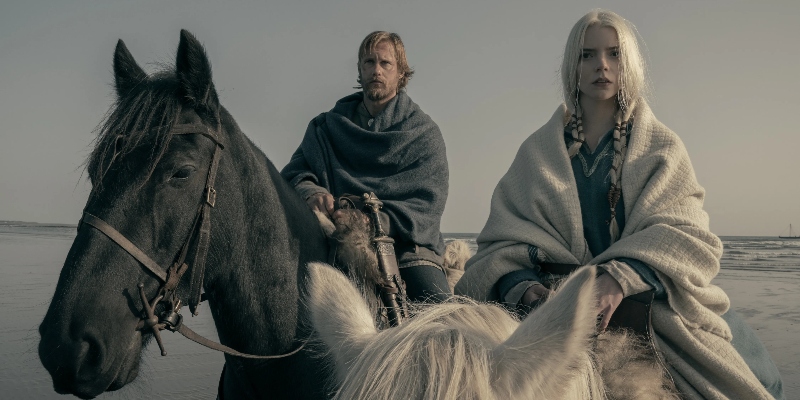
Gender
By Sedina Ackuayi, Mila Barry, Sam Meacham, Mihir Kumashi, Arjun Nageswaran, and Kamryn Ohly
“Your strength breaks men’s bones. I have the cunning to break their minds,” says Olga of the Birch Forest, the Ophelia of The Northman and the brains of the operation, gendering the concept of strength into male brutality and female ingenuity.
“Romanticising the muscular man of violent action” leads to “dehumanising women as objects won and possessed by such men,” Susan Hopkins writes. Women become “both objects of desire and disdain … deployed only to define the character of the man.” Hopkins in particular would question the male character in The Northman needing to save his mother, noting how it follows the trope of “a heroic man protecting or avenging ‘his’ … women.”
In Saxo’s text, toxic masculinity leads directly to violence against women. A duel between Horwendil and a rival king, Koll, ends with Horwendil glibly murdering Koll’s sister, Sela. Her death is character development for Horwendil. Feng’s lust for Gerutha brings him to murder his brother: “Gerutha … though so gentle that she would do no man the slightest hurt, had been visited with her husband’s extremest hate; and it was all to save her that he had slain his brother.” Gerutha exists solely to provide motivation for men to kill each other.
Amleth unabashedly accuses Gerutha of “wantoning like a harlot” and “redeem[s] her to walk in the ways of virtue.” She has no dialogue in this scene and is barely mentioned again until she is murdered. Amleth’s speech to the court upon becoming king is replete with references to defiled feminine virtue: “Pity also my stricken mother and rejoice with me that the infamy of her who was once your queen is now quenched.”
Women in Feng’s and Amleth’s fantasies are reduced to objects of desire, damsels in distress who excuse and motivate violence.The “obliging maid” who is unnamed is used by Feng’s court to bait Amleth and detect if he is only “play[ing] the simpleton … to hide his understanding.” She falls in love with Amleth. He reveals his plot to her. They conspire to defeat corruption in the kingdom. She successfully lies about his madness, leading him to be sent to Britain.
Women in Feng’s and Amleth’s fantasies are reduced to objects of desire, damsels in distress who excuse and motivate violence. The enemies Amleth and Feng are less opposites than they may seem. Both are violent men driven by romanticized chivalric fantasies of rescuing women from the clutches of an evil man, feminine purity part of their justification for murderous revenge.
Amleth later marries a second wife, Hermutrude, perhaps the most powerful character depicted in the story besides Amleth. Yet all this character-building is undone by the end, where Hermatrude betrays the dead Amleth by marrying his killer. In Saxo’s opinion, “All vows of women are loosed by change of fortune and melted by the shifting of time.”
“Woman, thy name is frailty” was Shakespeare’s version of demeaning an entire gender based on the actions of a single woman. In Hamlet, Queen Gertrude is depicted as a foolish character, too meek, ignorant, and emotional to make executive decisions.
Ophelia fights through self-sacrifice, intellect, and rebellion rather than physical violence, demonstrating that strength is a multifaceted concept, as Sarah Gates argues in “Assembling the Ophelia Fragments.” Ophelia’s strength in her intellect is not utilized by Hamlet, as he keeps her in the dark about his revenge plot, leading to its failure. Had she been trusted, like Saxo’s maid, she might not have betrayed Hamlet to the court.
The Northman comes from a lineage of deeply sexist narratives where the stories of women can only be recuperated through imaginative feminist readings that outmaneuver the misogyny of the authors. The Northman portrays its female characters as harsh, fearless warriors. Queen Gudrún—played by high-profile actress Nicole Kidman—possesses autonomy and power. When a young Amleth announces the return of the king, her lack of response implies a cold demeanor and a lack of dependence on her husband’s presence. In one scene, she appears in armor, holding a whip-like object in her hand, which she slashes down in power. She is surrounded by armed soldiers, in control of these men, an equal to Fjölnir—an empowered 21st-century version of the slighted 7th-century queen.
The things that empower Gudrún bear a striking resemblance to masculine revenge fantasies—lack of emotionality, masterful violence, an eroticized warrior visage. Audiences perceive her as empowered because she is now closer to manhood, not because she has claimed womanhood. And she remains a side character, a pawn to be “saved” by her son. The appearance of autonomy distracts from the fact that, structurally, her role in the story hasn’t changed since the 13th century.
Race
By Arielle Frommer, Hayat Hassan, and Eliza Hirsch
“Race cannot be ignored,” David Sterling Brown writes, “even in what may appear to be one of Shakespeare’s whitest plays.” Precisely because texts like Hamlet and The Northman are so relentlessly white, they allow us to watch whiteness work.
A tall, blonde, rugged, shirtless, Swedish Alexander Skarsgård marches through the snow, charging into a blood-soaked battlefield and plunging a spear into the chest of his enemy as the sounds of war echo around him. Nicole Kidman, the celebrated Australian portraying Amleth’s mother, is a natural redhead, but her character’s hair is light blonde in the film. Casting calls for The Northman must have been short and to-the-point: the whiter the better.
The veneration of northern medieval Europe in The Northman falls uncomfortably in line with recent white supremacist propaganda about Vikings. Many of the creative choices in The Northman pander—even if unintentionally—to white supremacist ideals and the historically inaccurate idea of a uniquely white Viking heritage.
Writing for Time, Dorothy Kim explains that the word “Viking” is an old Norse word describing groups of 10th- and 11th-century sea-faring pillagers who colonized and raided land from Ireland to the Mediterranean, Arctic, Black, Caspian, and North Atlantic seas. The Vikings being an ethnically homogeneous Scandinavian people is highly unlikely, given the amount of cultural fluidity in Medieval Europe at the time. These groups were multicultural and multiracial.
The Viking Cinematic Universe is a racist fiction.Kim traces the whitewashing of the Vikings to 19th-century rewritings of history that promote a white German state known as the Völkish movement. By utilizing folklore and medieval stories, leaders in the movement centered white characters in history to promote white racial supremacy. Similarly, Karl Steel writes that white supremacist groups highly valued the autonomy and commitment to duty of the Vikings. They valorized Vikings for their fraternal and honor-based culture.
During the Third Reich, Nazis adopted the Odal symbol from the Runic alphabet for their Aryan supremacy movement. The Odal rune, which represents ancestral heritage, was put on badges and given to soldiers who achieved high honor in the SS battalion. The symbol has since been outlawed in Germany but is still used by white supremacist and Nazi groups throughout the world. The “o” in The Northman’s marketing closely resembled the Odal rune but was later changed.
Recent years have seen a spike in the popularity of Vikings, as in the Thor franchise and the History Channel’s Vikings series. These channels present familiar images of blond-haired, blue-eyed, hulking Vikings, frothing at the mouth, wearing horned helmets, jumping out of their longship to pillage some monastery before carousing and drinking ale from the skulls of their defeated foes. The Viking Cinematic Universe is a racist fiction.
Recent years have also seen Norse stories appropriated by white nationalist groups. Kim describes groups like the Odinists “who practice a form of white toxic masculinity based on the belief that the ‘barbaric’ warriors of medieval Northern Europe functioned as a violent warrior comitatus.” The shooter who massacred 50 people at mosques in Christchurch, New Zealand, in 2019 had repeated references to the Odal rune and Viking culture in a white supremacist manifesto he wrote prior to the shootings. Likewise, rioters stormed the United States Capitol on January 6 wearing Viking horns.
Artists like Eggers could learn from those already deconstructing these false ideals, such as Taika Waititi, an indigenous Maori director who directed Thor: Ragnarok (2017). In the film, Thor’s hammer, another symbol for white supremacist groups, is destroyed, along with the violent and dangerous beliefs associated with it. In contrast, The Northman declines the opportunity to challenge public understanding of Vikings by offering a more ethnically diverse cast, in favor of coddling white viewers who are sick of “shoe-horned diversity.”

